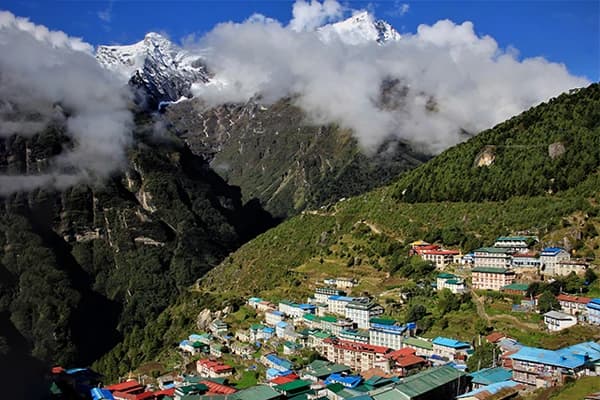Outline the itinerary for the Annapurna Base Camp Trek 2025
- Day 1: Arrival at Tribhuvan International Airport and transfer to hotel
- Day 2: Kathmandu Valley Excursion and trek preparation
- Day 3: Drive to Pokhara via tourist bus
- Day 4: Drive to Nayapul and then trek to Ulleri (1,960 meters).
- Day 5: Trek from Ulleri to Ghorepani (2,750 meters)
- Day 6: Climb to Poon Hill (3,200 meters) and trek to Tadapani.
- Day 7: Hike from Tadapani to Chhomrong (2,210 meters)
- Day 8: Trek for 2 to 3 hours from Chhomrong to Bamboo (2,310 meters)
- Day 9: From Bamboo hike to Deurali (3,140 meters)
- Day 10: Deurali to Annapurna Base Camp for 5 to 6 hours (4,130 meters)
- Day 11: Hike from Annapurna Base Camp to Bamboo for 6 hours (2,345 meters)
- Day 12: Trek to Jhinu Danda (1,780 meters) from Bamboo
- Day 13: Jhinu Danda to Nayapul and drive back to Pokhara
- Day 14: Drive from Pokhara to Kathmandu
- Day 15: Farewell and airport transfer
Weather & Temperature of Annapurna Base Camp in Winter 2025
The winter season brings snow and chilly weather at the Annapurna Base Camp trek. The Annapurna base camp temperature in December ranges from -10 degrees Celsius to 10 degrees Celsius during the day, while it falls to -20 degrees Celsius or lower at night. The days will be shorter with only 9 to 10 hours of daylight.
The Annapurna base camp temperature in November is -9 degrees Celsius to 11 degrees Celsius during the day, and it drops to -19 degrees Celsius at night. In other months of winter, the temperature ranges from -10°C to 10°C, with an average of around -5°C.

The winter season means cold temperatures and months of snow at higher altitudes. You have to bring warm clothing, including a down jacket, warm gloves, and a hat. The occasional snowfall at higher altitudes will make the trek more challenging due to the slippery trail. Due to shorter daylight, you need to start your hike early in the morning and end it before sunset. The beautiful scenery of snow-capped mountains, clear blue skies, and pristine snowfall will make your hike to the Annapurna Base Camp in winter a rewarding experience.
The cold and chilly weather, along with the less-crowded trekking trail, will make your hike more beautiful and joyful. The sunlight makes a favorable climate for walking throughout the day. February and January receive frequent snowfall, so you need to be well prepared with the right equipment and clothing.
Food & Accommodation
The winter season is an off-season for Annapurna Base Camp trekking. Most of the hotels and lodges shut down their business in the winter season due to fewer travelers, while some hotels and lodges are still open. Since the trek to the Himalayas passes through remote areas, all of the supplies and food served in the hotel are either flown in on helicopters or transported using mules and horses. This makes the dishes served more expensive than those in urban areas.
The hotel and teahouses offer some discount offers on the dishes and delicacies in the winter season. You will save some money compared to other peak seasons. The fewer crowds in the hotel, the less time you will spend standing in the long line for food. Besides this, there will be limited items on the menu, and they will serve you all organic dishes. There are cheaper rates for the room, and you can ask for a single room with an attached bathroom. You shouldn't share the room with your fellow travelers and can enjoy your personal space.
Difficulty during ABC trek in Winter 2025
The Annapurna Base Camp trek in the winter season welcomes many challenges and disasters. This is characterized as a moderate level of trekking that will be completed without any kind of technical skills or previous experience. Due to its location above 4000 meters, you will experience many hurdles in this region. The physically fit hiker and those who are born and raised in higher altitudes have slight advantages in the acclimatization process as well as in walking every day.
The preparation and physical ability will help you overcome the overall difficulty of the expedition. Some of the major hurdles that you will experience during the trek are given below:
- Altitude sickness: You will suffer from altitude sickness at an altitude of over 2500 meters from sea level. It is characterized by trouble in the adjustment of the body due to low oxygen availability at higher altitudes. You need to pay attention to the symptoms of altitude sickness during the hike to Annapurna Base Camp.
- Trekking duration: The overall distance of Annapurna Base Camp is approximately 110 km. So, you need to walk for more than 6 hours a day, which requires physical capabilities as well as mental well-being. It will be difficult for you to hike at a higher altitude with limited oxygen availability.
- Acclimatization: Acclimatization is necessary for trekking because it gives your body enough time to reshape and replenish the lost energy. The acclimatization in the cold temperature of the winter season is more challenging. You need a rest day to avoid altitude sickness as well.
- Weather Factor: The winter season is considered off-season in the aspect of trekking. Due to the cold weather, there might be occasional snowfall, so you need to walk across the snow-covered trekking trail. You need to bring warm clothes, which are usually heavy and make your backpack heavier. You need to bring appropriate shoes just for walking above the snow-covered trails.
- There is a possibility of regular snowfall and blizzards at higher altitudes. The heavy blizzard may block the trails, which results in the closure of the passes.
- The days are shorter so you need to start the trek early in the morning and reach the tea houses before it gets dark, which makes you walk fast to cover the distance.
- The cold weather and snowfall cause many teahouses to close, which will make it difficult to spend a night at hotels.
- There is the highest probability of avalanches and heavy snowfall at higher altitudes, which cause blockages on the trekking trail.
Trekking Tips for Annapurna Base Camp Trek in Winter 2025
The Annapurna Base Camp trekking is considered a challenging trek and trekking in the winter season makes it more challenging and adventurous. The cold weather and snowfall make it difficult to complete the trek. Here are some tips that will help your trek succeed:
- Bring warm clothes, a sleeping bag, and a good-quality down jacket to avoid catching a cold in the Himalayas.
- Make sure to bring enough trekking equipment, like a trekking pole, waterproof boots, crampons, and ice axes, which will be useful to maintain balance on the slippery trail.
- You need to start your hike before sunrise and reach your destination before sunrise, as the days are shorter in the winter season.
- Acclimatize properly and drink enough water to avoid altitude sickness.
- Bring enough cash, as there are no ATMs and no online transactions at the higher altitude.
- Learn and stay informed about the weather, trail conditions, and other updates from the guides and owners of tea houses and lodges.
- Without a local guide, you cannot hike to the Annapurna Base Camp in any season, so hire a certified local guide.
- Obtain all the necessary permits, like a TIMS (Trekkers Information Management System) card and an Annapurna Conservation Area Permit (ACAP), from your trekking agency or guide.
- Walk in a slow and steady position, making your body adjust to the new altitude.
- Carry a water purification tablet for safe drinking water along with instant energy bars, high-energy snacks, and chocolate.
- Bring medicine like acetaminophen, aspirin, ibuprofen, naproxen, and dextromethorphan in case you catch a cold or cough.
Annapurna Base Camp Trek preparation for winter 2025
The Annapurna Base Camp trek requires enough preparation for trekking in the winter season. The winter season in Nepal comprises late November, December, January, and February. The whole country experiences chilly nights and warm days. The trekking trail at Annapurna base camp takes you to an altitude of 4,130 meters above sea level. You will experience a moderate climate at lower altitudes and snowy and chilly weather at higher altitudes. You need to practice walking in a cold environment so that your body will easily adjust to the higher altitudes.

Trekking to higher altitudes brings the risk of altitude mountain sickness, even though you are physically and mentally fit. So, a positive mindset and a slow pace are required to avoid altitude sickness. You should also practice walking uphill, descending downhill, and climbing the paved staircases before a month of your scheduled trek. Make sure to bring a knee guard for knee problems, painkillers, bandages, and pain-relieving ointment for emergencies.
Documents required for Annapurna Base Camp Trek in winter 2025
You must have permits before starting your trek to the Annapurna Base Camp in every season, whether it’s summer, monsoon, winter, spring, or autumn. Your trekking agency or guide will take care of your necessary documents and permits. The Annapurna Base Camp trek requires an ACAP (Annapurna Conservation Area Project) permit and a TIMS card. ACAP costs 3,000 NRS for foreigners and 200 NRS for SAARC countries.
You need to pay NRS 1,000 for a TIMS card. These permits can be obtained from the Nepal Tourism Board in Kathmandu; without a permit, you need to pay a penalty at the checkpoints.
Merits & Demerits of Annapurna Base Camp Trek in winter 2025
Trekking in the Annapurna Base Camp during winter has both merits and demerits. The adventure lover enjoys this trek fully while encountering snowfall and other weather conditions. Winter brings more difficulties in the higher-altitude region. The snow-covered trekking trail adds difficulties to the journey of Annapurna Base Camp.
The merits of the Annapurna Base Camp trekking in the winter season are given below:
- There are fewer people on the trail, which allows you to find accommodation easily and helps you enjoy the serenity of the mountains and connect with nature.
- The breathtaking scenery, snow-covered lowland, frozen waterfall, and icy rivers make the environment unique and magical.
- Fewer expenses in accommodation and food help save some money for budget-conscious travelers.
- It is a perfect season for celebrating the traditional Gurung festival, Tamu Lhosar, while witnessing the other colorful festivals and cultures.
Here are the demerits of the Annapurna Base Camp Trek in the winter season:
- The winter season in the Himalayas is extremely chilly. The temperatures fall below freezing point at night, so bringing enough clothing and gear makes your baggage weighty.
- Snowfall at higher altitudes makes your trekking journey more challenging, making the trail slippery with ice. You should be mentally and physically fit to trek at a higher altitude.
- Some tea houses and lodges shut down their business during the off-season. This will make it difficult for you to locate the accommodation. In addition to this, newly opened tea houses and lodges provide limited facilities, so you must come prepared with your supplies.
- The snowy weather makes it difficult to navigate, which resulted in the cancellation of flights. There will be a delay in your departure date, so you must have a flexible schedule.
Flora and Fauna of the Annapurna Base Camp in the Winter Season 2025
There is a wide range of flora and fauna in the Annapurna region. They are preserved under the Annapurna Conservation Area, which spans an area of 7,629 square kilometers of the central Himalayas in Nepal. The path takes you through a wide range of terrain, lush forests, and high-altitude glaciers. You will encounter many extinct varieties of flora and rare fauna while trekking through the Annapurna Base Camp region. You will see many types of flora and fauna while trekking in the winter season.
The Annapurna region is a habitat of many medicinal and endemic plants and vegetation. You will pass through bamboo forests, which are commonly found at lower elevations. It adds greenery to the dense forest and acts as a habitat for many reptiles and birds. You will see a wide range of stunning rhododendron forests and oak trees.
The splendid transformation of orange and yellow hues of oak leaves makes the trekking trail more beautiful. The Himalayan pine tree covered most of the trekking trail, and the aroma of pine needles spreading all over the trail boosts your lost energy. Pine needles are also used for making tea. You will encounter juniper shrubs at higher altitudes, which are globally recognized for their medicinal properties along with their fragrance. There are stunning wildflowers like primroses, daisies, and marigolds, which make the lowlands more colorful.
The winter season makes it more difficult to spot animals at higher altitudes. The lucky one will be able to see diverse wildlife while hiking in the Annapurna Base Camp region. The Annapurna region is the main habitat of Himalayan tahr, snow leopards, musk deer, red pandas, monkeys, etc. Most of the hikers encounter snow leopards and musk deer, which are considered very rare to spot in the Annapurna region.
Besides this, many birds, reptiles, and amphibians are also available for sightseeing. You can also see the Himalayan monal, popularly known as Danfe, which is the national bird of Nepal. You should walk cautiously without interfering with the habitat of wildlife, which results in the disappearance of the wildlife. So, you have to walk while taking care of nature and without disturbing the wild ecosystem.
Why the Annapurna Base Camp Trek in winter 2025?
The Annapurna Base Camp trek in winter is enjoyable and is perfect for that traveler who likes crowds. It offers utter silence on the trail while enjoying the natural beauty. You should consider trekking in the Annapurna Base Camp trek in the winter season for the following reasons:
- The flawless and serene atmosphere: There is a clear sky with the perfect atmosphere. The weather makes your journey lovable and worthy after a long day of hiking.
- Less Crowds: Due to the off-season, there will be fewer crowds on the trekking trails. The winter season offers a peaceful and serene setting, along with the magnificent Himalayas. You will have enough time to socialize with guides and porters. There will be no distraction from the natural beauty, and you can enjoy it without any rush. You will experience peaceful ambiance and solitude, providing an opportunity to connect with nature.
- Natural hot water springs: You will get the opportunity to bathe in natural hot springs. Jhinu Danda offers a hot spring where you can take a warm bath, which will remove all the tiredness and pain resulting from trekking. There is a belief that this natural hot spring removes pain from your joints.
- Unique Exploration Perspective: You will get an opportunity to explore the Annapurna region in the winter season. You can explore different sides at its pinnacle. The snow-covered landscape of this region will surely make the journey spectacular. You will be amazed by the unique blend of striking light in the snow-clad landscapes of the winter season. This makes your adventure worthwhile.
- Easy accommodation: You can stay in the room of your choice and get a room with a mountain view easily. There is no need to share your comfort zone with fellow teammates at night, as you can get a single room with an attached bathroom. The stable and clear weather makes your journey more memorable. There will be more options, and services will be faster. They will serve your choice of food if the items are available.
- Clear Views and Chilly Air: The chill and crisp air will add freshness to the everyday trek. In other seasons, you will suffer from heat, while trekking in winter will avoid this. The fresh air will make your hike enjoyable if you are dressed properly. Besides this, winter will offer you spectacular views of the Himalayas, like Annapurna I, Annapurna II, Annapurna III, Annapurna South, Fishtail, Gangapurna, Tent Peak, Hiunchuli, and Annapurna IV. You can enjoy the snow-covered mountains and experience snowfall at higher altitudes.
To sum up..
In conclusion, the Annapurna base camp welcomes trekkers in the winter season as well. If you have a determined mentality with enough well-being, nothing, like wind or snow, will stop you from completing the Annapurna Base Camp trek. The clear and bright daytime weather helps you to walk with passion while witnessing the diverse vegetation, flora, fauna, and terrain landscapes. The winter trek to Annapurna Base Camp brings many obstacles, like slippery terrain and snow-covered views of mountains, but is worth visiting.
There is a chance of experiencing snowfall at a higher altitude, and you can click pictures with your fellow travelers, which could be a lifetime opportunity for you. The picturesque trail of Annapurna Base Camp combines with other popular trekking trails like Poon Hill, Mardi Himal, Mohare Danda, Khopara Lake, and Jomsom. If your schedule is flexible, you can hike in this region.







